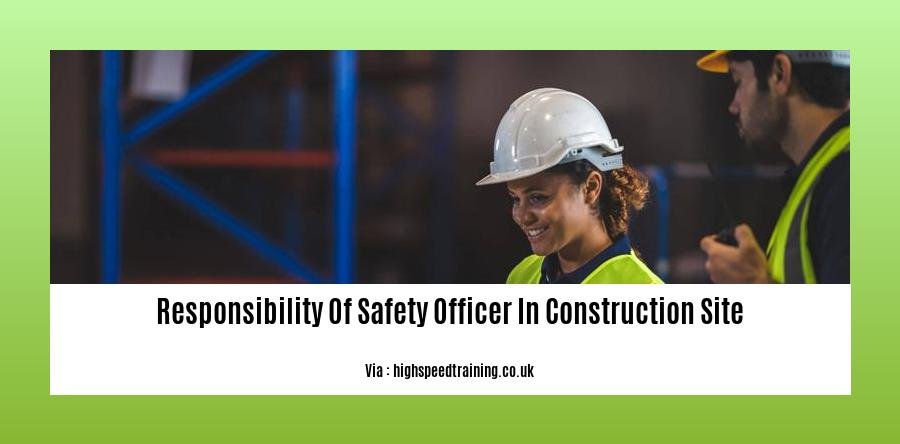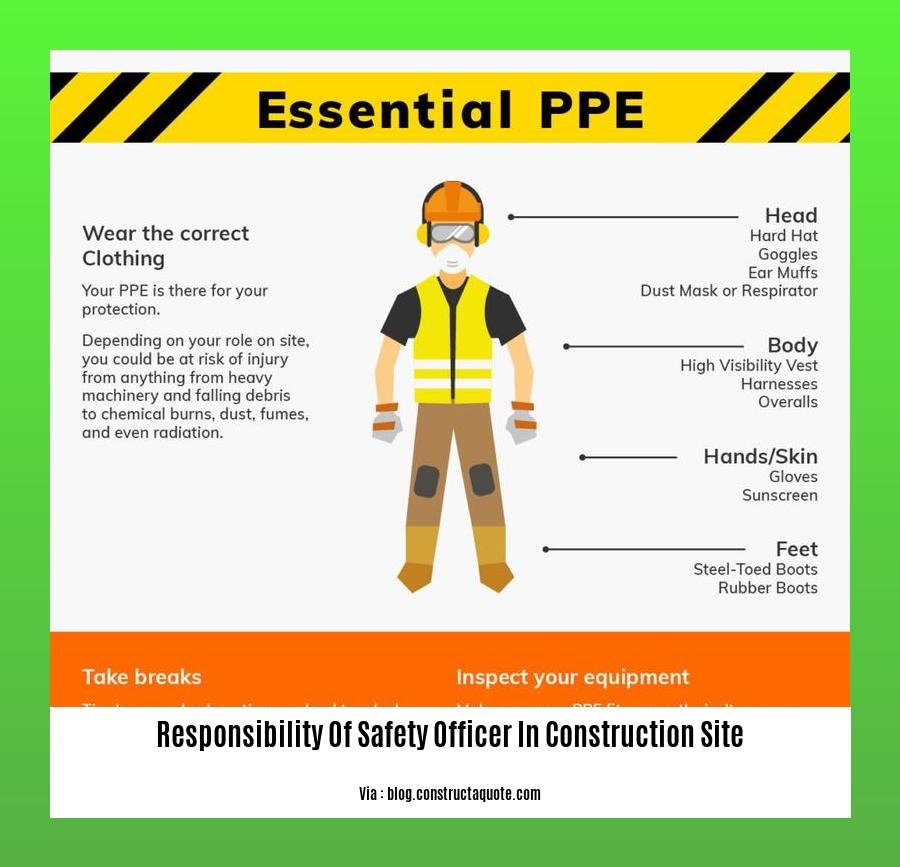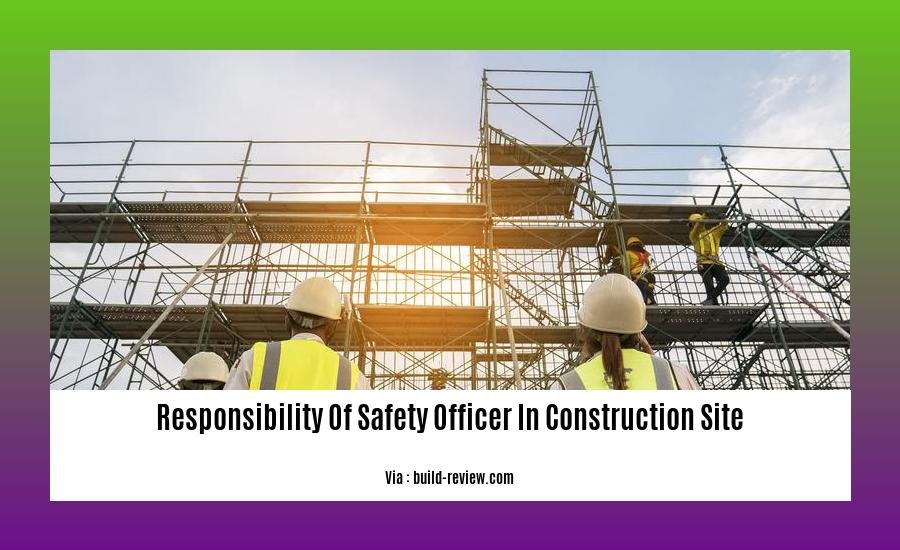Embark on a journey through the multifaceted responsibilities of safety officers in construction site management. In this comprehensive guide, we’ll illuminate the crucial steps involved in ensuring a secure and efficient work environment: [1 Step 1: Plan ahead 2 Step 2: Inspect the site 3 Step 3: Assess the risks 4 Step 4: Control the hazards]. Join us as we delve into the intricacies of safety officer responsibilities in construction site management, empowering industry professionals to create safer and more productive work environments.
Key Takeaways:
- Conduct regular inspections to identify and eliminate hazards.
- Review and approve subcontractor safety plans for compliance.
- Inspect tools and equipment for quality and condition.
- Promote safe practices and enforce safety guidelines.
- Develop and implement procedures to reduce accident risk.
- Identify and assess construction activity hazards and risks.
- Investigate accidents to find root causes and develop corrective actions.
- Train workers on safe equipment use.
Responsibility of Safety Officer in Construction Site Management

As a safety officer, the well-being of construction site workers is placed in your capable hands. Your vigilance ensures a safe and healthy work environment, fostering productivity and minimizing risks. Here’s a comprehensive guide to your crucial responsibilities:
Hazard Identification and Mitigation
- Conduct thorough site inspections to identify potential hazards, such as unstable structures, electrical hazards, and chemical spills.
- Assess risks associated with each hazard and implement appropriate control measures to mitigate them.
- Establish clear protocols for reporting and addressing hazards promptly.
Safety Promotion and Implementation
- Engage workers, supervisors, and subcontractors in safety briefings and training sessions.
- Develop and enforce comprehensive safety guidelines, policies, and programs.
- Promote safe behaviors and encourage a culture of accountability.
- Regularly evaluate compliance with safety regulations and standards.
Risk Management and Investigation
- Identify and assess potential hazards and risks associated with construction activities.
- Develop risk management plans to minimize the likelihood of accidents and injuries.
- Investigate accidents thoroughly to determine root causes and implement corrective actions.
- Track and analyze accident data to identify trends and develop preventive measures.
Emergency Preparedness and Response
- Develop and implement emergency response plans for various scenarios, including fires, explosions, and medical emergencies.
- Conduct regular emergency drills to ensure effective response.
- Maintain essential safety equipment and supplies on-site, such as fire extinguishers, first aid kits, and evacuation routes.
Collaboration and Communication
- Collaborate with project managers, engineers, and other stakeholders to ensure safety is integrated into all aspects of the project.
- Communicate safety regulations, procedures, and updates clearly and effectively to all personnel.
- Foster a positive safety culture that encourages open communication about hazards and concerns.
Training and Development
- Provide comprehensive safety training to workers on various topics, including hazard identification, safe work practices, and emergency response.
- Regularly update and enhance safety training programs to address emerging risks and new regulations.
- Encourage professional development and certifications for safety personnel.
Remember, the safety of construction site workers depends on your expertise, vigilance, and commitment to ensuring a safe and productive work environment.
It is also crucial to have a comprehensive safety equipment list for construction to ensure that workers have the necessary gear to protect themselves from potential hazards. By implementing these measures, construction sites can establish a culture of safety that prioritizes the well-being of workers and minimizes safety concerns in construction. Additionally, a designated safety board for construction site can facilitate regular safety inspections and audits to identify and address potential risks. Ensuring that construction workers have access to safety gear is paramount for their protection.
**3

Step 3: Assess the risks**
When it comes to construction site management, assessing risks is paramount. As safety officers, we must proactively identify potential hazards and evaluate their likelihood and severity. By doing so, we can develop effective strategies to mitigate these risks and prevent accidents.
Imagine a construction worker operating heavy machinery. They might face the risk of equipment failure, which could lead to serious injury or damage to property. Our job as safety officers is to assess this risk, determine its likelihood and severity, and create protocols to minimize the chances of it occurring.
Risk assessment involves a thorough examination of the workplace, equipment, and work practices. We consider factors such as the type of work being performed, the environment, and the potential for human error. This assessment helps us prioritize risks, allocate resources, and establish control measures.
Key Takeaways:
- Identify potential hazards: Conduct regular inspections and review project plans to identify potential hazards.
- Assess likelihood and severity: Determine the probability of a hazard occurring and the potential consequences.
- Develop mitigation strategies: Implement measures to reduce the likelihood or severity of identified risks.
- Monitor and review: Regularly review and update risk assessments to ensure they remain effective.
Relevant URL Sources:
- Construction Safety Officer Responsibilities and Activities
- The Importance of Risk Assessment in Construction
Step 4: Control the hazards
Controlling hazards is a critical step in the risk assessment and management process. It involves taking steps to eliminate or reduce the risk of a hazard causing harm. This can be done through a variety of measures, including:
-
Engineering controls: These involve making physical changes to the workplace or equipment to reduce the risk of injury or illness. For example, a guard can be installed on a machine to prevent workers from getting injured by moving parts.
-
Admin controls: These involve changing the way work is done to reduce the risk of injury or illness. For example, a company may implement a policy that requires workers to wear certain types of safety gear or to follow certain procedures when working with dangerous chemicals.
-
Personal protective equipment (PPE): This involves providing workers with protective gear to reduce the risk of injury or illness. For example, workers may be required to wear gloves, safety glasses, or hearing protection when working in certain areas.
It is important to note that controlling hazards is an ongoing process. As new hazards are identified, new controls must be implemented to reduce the risk of injury or illness.
Key Takeaways:
- Controlling hazards is a critical step in the risk assessment and management process.
- There are a variety of ways to control hazards, including engineering controls, admin controls, and personal protective equipment (PPE).
- Controlling hazards is an ongoing process. As new hazards are identified, new controls must be implemented to reduce the risk of injury or illness.
Relevant URL Sources
[1] How to Control Safety and Health
Risks in the Construction Industry
[2] Controlling Safety and Health
Risks in Construction
FAQ
Q1: What are the key steps involved in ensuring a safe construction site?
A1: The four key steps are:
1. Plan ahead
2. Inspect the site
3. Assess the risks
4. Control the hazards
Q2: What should safety officers look for during site inspections?
A2: Safety officers should inspect the site to identify potential hazards, such as unstable structures, electrical hazards, and unsafe equipment.
Q3: How do safety officers assess risks?
A3: Safety officers assess risks by identifying the likelihood and severity of potential hazards. They consider factors such as the number of workers exposed to the hazard, the duration of exposure, and the potential consequences of an accident.
Q4: What are some common ways to control hazards on a construction site?
A4: Some common ways to control hazards include:
– Using engineering controls, such as barriers and guards
– Implementing administrative controls, such as safety procedures and training
– Providing workers with personal protective equipment (PPE)
Q5: What should safety officers do in the event of an accident?
A5: In the event of an accident, safety officers should:
– Secure the scene
– Call for medical help
– Investigate the accident to determine the cause
– Take steps to prevent similar accidents in the future
- Are Daffodils Perennials?A Complete Guide to Planting & Care - March 31, 2025
- Are Carpenter Bees Dangerous? Stings, Damage, and Control - March 31, 2025
- How to Get Rid of Ants in the Washroom: A Complete Guide - March 31, 2025










